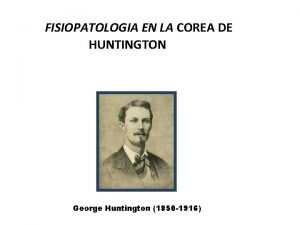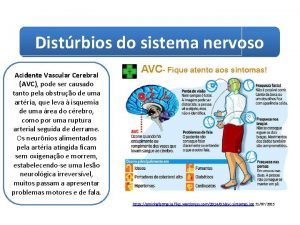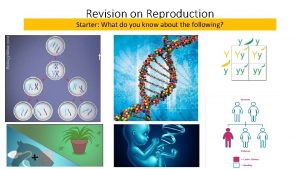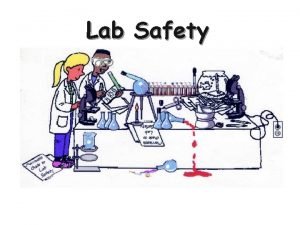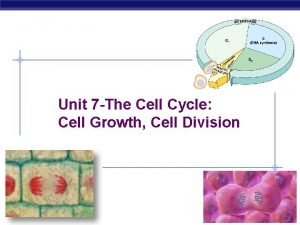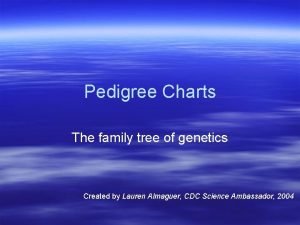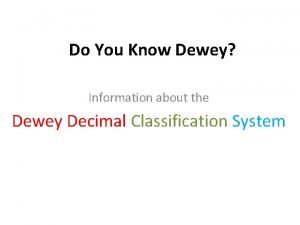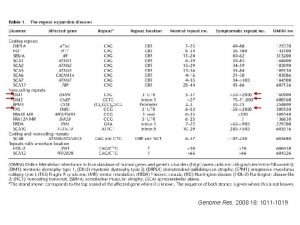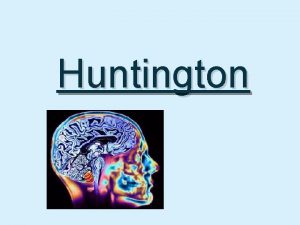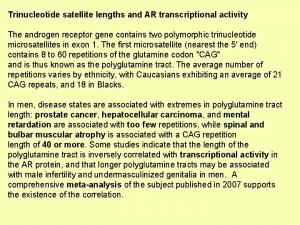Trinucleotide repeat disorders Huntington Disease You MUST know
































































- Slides: 64

Trinucleotide repeat disorders: Huntington Disease You MUST know material on course page objectives Review pages 217 -220 in Gelerhter/Collins/Ginsburg text

“We used to think our fate is in the stars. Now we know, in large measure, our fate is in our genes. ” - James Watson

Types of Mutations • Single base pair substitutions • missense, nonsense, splice site • • • Deletions Duplications Inversions Insertions Repeat Expansions

Outline of Lecture • • • Overview of types of trinucleotide repeat disorders Huntington disease Molecular testing for trinucleotide repeat disorders Ethical, legal, and social implications of predictive testing Pathophysiology of trinucleotide disorders Discussion with visiting patient and her family

Trinucleotide repeat: a type of short tandem repeat CAG 7 repeats 8 repeats • The size of repeat region varies between individuals and is polymorphic in normal individuals • For some trinucleotide repeats, when the number of repeats exceeds a certain threshold, a neurological disease results

Timeline of Gene Discoveries for Trinucleotide Repeat Disorders • • 1991 1992 1993 1994 1996 1997 1999 2000 s Fragile X MR syndrome, SBMA Myotonic dystrophy Huntington disease, SCA 1, FRAXE, DRPLA/HR Machado-Joseph disease/SCA 3 SCA 2, Friedreich ataxia, SCA 6 SCA 7 SCA 10, SCA 5, SCA 4 Other SCAs, Psychiatric disorders?

Major Features of Most Trinucleotide Repeat Disorders • Neurological/cognitive symptoms • Many are autosomal dominant with variable expression (exceptions: Friedreich ataxia (recessive); Spinobulbar muscular atrophy, Fragile X syndrome, FRAXE MR - X-linked recessive) • Later age of onset (exceptions: congenital myotonic dystrophy, Fragile X syndrome, FRAXE) • Meiotic and mitotic instability with some degree of anticipation in many of the conditions

Why Know About Trinucleotide Repeat Disorders? • Over 15 genetic different disorders that cause a significant proportion of inherited neurological disease in adults and the most common cause of inherited mental retardation in males (Fragile X syndrome) • Molecular diagnosis is available for diagnostic confirmation, predictive testing, prenatal testing, preconception testing, and preimplantation diagnosis. • Genetic counseling issues are complex and important to understand as are related ethical issues

FMR 1 in FRAXA Mental Retardation • 17 exon FMR 1 gene cloned in 1991 • Highest FMR 1 expression in neurons and spermatogonia • FMR 1 P associates with translating ribososmes and is involved in nucleocytoplasmic shuttling • Approximate repeat ranges: • • 6 -45 CGGs (0 -3 AGGs) 46 -60 CGGs (0 -2 AGGs) 60 -200 CGGs > 200 CGGs - Unmethylated, Stable, Normal Unmethylated, +/- Instability, Normal Unmethylated, Premutation - Unstable, Normal Methylated, no FMR 1, Unstable, Affected

Myotonic Dystrophy • Common adult-onset muscular dystrophy (1 in 8000 in Caucasians, 1 in 475 in Quebec • • Autosomal dominant - 19 q 13. 2 -. 3 Expansion of 3’ UTR CTG repeat in 15 exon myotonic dystrophy protein kinase gene (DMPK) – 5 - 37 normal – 50 - 90 mild - cataract, balding, limited muscle involvement, > 50 years – 90 - 1000 classic muscle weakness, myotonia, cataracts, onset 20 -30 years – > 1000 often congenital, hypotonia, developmental delays Instability of repeats - 10% expansion, 3% contraction. Congenital DM always due to maternal expansion

Anticipation Increasing severity and/or decreasing age of onset of an inherited disease in successive generations within a family.

• Friedreich Ataxia: – Autosomal recessive progressive neurological disorder, onset < 25 years with ataxia due to expansion of GAA repeat in intron of FRATAXIN gene • Spinocerebellar Ataxia (many types): – Autosomal dominant progressive neurological disorder characterized by ataxia usually in the 3 rd or 4 th decade due to expanded CAG repeat in coding exons of SCA genes • Myotonic Dystrophy: – Autosomal dominant progressive neurological disorder with variable expression and anticipation due to expansion of 3’ UTR region of DMPK gene • Fragile X syndrome: – X-linked recessive mental retardation syndrome due to expansion of CGG repeat in 5’ UTR region of FRAXA gene

Trinucleotide repeat disorders can involve expansions of various repeats in coding and non-coding regions of the gene 5’ UTR exon intron exon 3’ UTR CGG GAA CAG CTG **FRAXA FRAXE FA **HD SCAs SMBA DRLPA MD

Individual with Huntington Disease Dr. George Huntington (1850 -1916) • Became interested in hereditary chorea in 1871 • Wrote his seminal paper on this disease when he was 22 in 1872 • Was a general practitioner - never on a medical faculty

Huntington Disease • Average of onset 40 years (range 2 - >80 years); Progression over 10 -25 years. • Movement disorder: choreic movements, twitching, balance problems, tracking problems, slowing of voluntary movement. In juvenile HD and in late stages of HD, rigidity and dystonia. • Cognitive dysfunction: problem solving, cognitive flexibility, short term memory, visuospatial functioning; progression to a global subcortical dementia • Personality changes: depression, apathy, irritability, impulsive behavior, affective disorders, rarely psychoses, increased alcohol use in early stages, increased suicide rate

Incidence of Huntington Disease per 100, 000 People African Blacks South African Whites Japan Finland Hong Kong American Blacks Western Europeans American Whites North Sweeden Tasmania, Australia Moray Firth, Scotland* Zulia, Venezuela 0. 06 2. 4 0. 38 0. 5 2. 5 3 -7 7 7 -10 144 174 560 (5 people in <1000) 700

Woodrow Wilson Guthrie

Woody Arlo Woody Guthrie Diagnosed in 1952, age 40 years Died 15 years later at age 55 years Abe During 17 year career wrote more than 1, 000 songs and left behind 2, 500 lyrics. Near the end of his life he could only use “yes” and “no” cards to communicate.

Phase Years Symptoms Transitional 0 -3 mood swings behavioral disturbances, hyperreflexia, memory impairment, increased clumsiness, impairment of voluntary movements, eye movement abnormalities Early 3 -5 dysarthria chorea gait abnormalities Middle 8 -10 Late 15 -25 bradykinesia, rigidity global dementia, dystonia, dysphagia incontinence, wasting, aspiration, bed ridden death



Pathology of Huntington Disease • Brain atrophy involving caudate nucleus and putamen with loss of striatal neurons and secondary atrophy of globus pallidus • Dilation of lateral and third ventricles • Additional atrophy throughout cortex, especially frontal and parietal lobes • Loss of small neurons precedes larger neurons with neurons utilizing GABA and enkephalin or substance P preferentially • Fibrillary gliosis

Huntington disease

Huntington Disease • IT 15/Huntingtin gene on 4 p 16. 3 cloned in 1993 • Disease mutation - CAG expansion in exon 1 – – – Repeat number 10 -28: 29 -35: 36 -39: 40 -100+: Outcome normal, no transmission of HD normal, paternal meiotic instability reduced penetrance (25%: 36 repeats, 90%: 39 repeats) will develop HD if person lives long enough • Increased meiotic instability in males - Paternal transmission of expanded allele associated with over 3/4 of juvenile disease • Encodes 348 k. D huntingtin protein which is a target for caspase 3, a protease associated with neuronal apoptosis




N N N HD N N

So the HD disease was cloned. . . now what? • Provide precise, rapid diagnosis including prenatal and predictive testing • Improve molecular understanding of pathophysiology • Increase ethical, psychosocial, and legal concerns • Improve medical management • Develop novel, targeted therapies

HD DNA testing: · Diagnosis confirmation · Prenatal diagnosis · Predictive diagnosis · psychosocial impact · employment concerns · insurance issues

Molecular Detection of Trinucleotide Repeats: Determine the size of the repeat • ‘Short’ Repeats (eg. HD): – PCR based typing of alleles using primers directly flanking repeat region - With appropriate controls and size marker the size can be determined accurately • Long repeats: determine size of the repeat – PCR and Southern blot analysis • Methlylation status (eg. Fragile X) • Immunoassays

17 24 46 41 A B C D A, B 220 20 180 160 140 120 100 80 B, D A, C A, D B, C B, D C, D A, B

Predictive or Presymptomatic Testing · How should cost and benefit be defined? · Many psychosocial issues · Who has a right to be tested or not to be tested? Who decides? · Who has a right to the results? · Probabilistic vs. Deterministic · susceptibility versus certainty of acquiring manifesting symptoms of a disease or disorder


PUBLIC HEALTH CODE (EXCERPT) Act 368 of 1978 333. 21072 a (1) A health maintenance organization shall not require an enrollee or his or her dependent or an asymptomatic applicant for coverage or his or her asymptomatic dependent to do either of the following: (a) Undergo genetic testing before issuing, renewing, or continuing a health maintenance organization contract. (b) Disclose whether genetic testing has been conducted or the results of genetic testing or genetic information.

THE INSURANCE CODE OF 1956 (EXCERPT) Act 218 of 1956 500. 3407 b (1) An expense-incurred hospital, medical, or surgical policy or certificate delivered, issued for delivery, or renewed in this state shall not require an insured or his or her dependent or an asymptomatic applicant for insurance or his or her asymptomatic dependent to do either of the following: (a) Undergo genetic testing before issuing, renewing, or continuing the policy or certificate in this state. (b) Disclose whether genetic testing has been conducted or the results of genetic testing or genetic information.

Positive outcomes: Predictive DNA Tests • Personal: • Positively influence life decisions and long term planning • Reduce morbidity and mortality by specific monitoring/surveillance, interventional risk reduction medical or surgical care, and/or lifestyle modifications • Family: • Inform own reproductive choices • Enable informed health care choices of family members • Society: • • • Improve medical care and health for populations at risk Help prioritize use of medical resources Facilitate development of molecular based therapies

HD Presymptomatic Testing: · Recommended Protocol(HDSA): · genetic counseling · neurological evaluation · psychological/psychiatric evaluation · DNA test if no concerns · identification of local support person · test results given in person · follow-up visits · no testing of presymptomatic minors

Affected Unaffected

Desirable Characteristics of Predictive Genetic Tests • “Negative” in unaffected individuals and people who aren’t predisposed to the disease – (eg. specific for the disease, low false positives) • “Positive” in affected individuals and those at increased risk of the disease – (eg. sensitive for the disease, low false negatives) • “Positive” test reflects prognosis and/or directs clinical management • Affordable, robust, reliable, reproducible!

Predictive tests are…. probabilistic NOT deterministic

Woody Arlo - 54 Arlo is asymptomatic, what are his chances of getting Huntington Disease? What are Abe’s chances? Abe

The Guthrie Family Humanitarian Award honors a scientist, researcher or medical leader who has demonstrated compassion and concern for the care and support of people with Huntington's Disease

Chance that an Asymptomatic Individual at 50% Risk for Inheriting Huntington Disease decreases with age Age 25 30 35 40 45 50 55 60 65 70 Risk(%) 49 48 46 43 38 31 25 19 13 6

UM MG Clinic Experience with Huntington Disease Testing

UM MG Clinic Experience with Huntington Disease Testing

Again, genetic testing is a process, not just a laboratory procedure…. • Pre-testing evaluation, education, genetic counseling, and informed consent • Laboratory analysis • Accurate interpretation of results • Follow-up must include psychosocial support, education, and management

Affected Unaffected

Affected Unaffected

+ DNA test Affected Unaffected

Predictive testing of minors for adult-onset conditions where there is no preventative or curative treatment. . . · Only when there is an effective, curative, or preventive treatment that should be instituted early in life to achieve benefit · At an age where children can understand implications and make informed decisions

Affected Unaffected

Anticipation, Meiotic Expansion, and Parent of Origin Effects for Different Disorders • • • HD paternal > maternal - mild C SCA 1 paternal > maternal -mild A DRPLA paternal > maternal - mild G SMBA paternal > maternal - mild DM maternal >>> paternal - significant FRAXA maternal >>> paternal - significant

Most CAG Trinucleotide Repeat Diseases: • Autosomal dominant progressive neurological disorders with variable expression and reduced penetrance • Demonstrate mild meiotic instability that is paternal in origin • Associated with normal alleles of 5 -34 repeats and disease alleles of 40 -100 repeats with an unstable intermediate repeat range • Demonstrate that age of onset, rapidity of progression, and severity of disorder correlate with increasing repeat size • CAG expansion leads to gain of function “neurotoxic” mutation

Pathophysiology of Expanded Polyglutamine Tracts • Knock out mice lack the neurological phenotype • Heterozygous transgenic mutant mice with expanded polyglutamine tracts exhibit neurological phenotype • Cell loss is an apoptotic event • The ‘toxic fragment’ hypothesis, where proteins are cleaved into a short toxic fragments with polyglutamine tracts that aggregate in the nucleus, has been raised • Association of CAG expansions with GAPDH suggests further roles for regulation of cellular metabolism • Key events regulating specificity of neuronal loss not understood

Potential Roles of Huntingtin • A handful of huntintin interacting proteins have been described and suggest additional roles for the protein: • HIP 1 (homologous to yeast gene with cytoskeletal functions) with affinity to normal sized tracts • HIP 2 which encodes an ubiquitin conjugating enzyme, • HAP 1 has affinity to larger polyglutamine tracts • GADPH has direct affinity for polyglutamine tracts and is involved in several key cellular functions • EGF receptor complex where huntingtin binds to SH 3 domains of Grb 2 and Ras-GAP suggesting some role in the EGF signaling pathway


Drug trials to prevent/slow HD symptom progression

Assessing Functional Capacity

Coenzyme Q 10 (dashed) vs no Coenzyme Q 10 (solid) Total functional capacity (TFC) Functional assessment Independence scale remacemide (dashed) vs no remacemide (solid)

A B C A. A normal nerve cell newly-injected with mutant HD genes B. The dying nerve cell with disappearance of the fingerlike processes C. Dying cells rescued by adding functional protein.

Trinucleotide repeat disorders are neurological disorders involving expansions of various repeats in coding and noncoding regions of the gene 5’ UTR exon intron exon 3’ UTR CGG GAA CAG CTG FRAXA FRAXE FA HD SCAs SMBA DRLPA MD

Summary • Trinucleotide repeat disorders account for a large proportion of inherited neurological and mental retardation conditions • Sensitive and specific DNA based diagnosis may be used for diagnostic, predictive, and prenatal testing if desired • Genetic counseling and education is useful for at-risk individuals to make informed choice about testing options • Huntington Disease is an autosomal dominant later onset progressive neurodegenerative disorder due to expansion of a CAG repeat in coding region • Guidelines for predictive and prenatal HD testing are wellestablished and serve as prototype for predictive testing for adult onset conditions

 Turner syndrome autosomal or sexlinked
Turner syndrome autosomal or sexlinked Stuff you must know cold
Stuff you must know cold Bharathi viswanathan
Bharathi viswanathan Postulates in boolean algebra
Postulates in boolean algebra Francesca turchetti
Francesca turchetti Fisiopatologia de corea de huntington
Fisiopatologia de corea de huntington Cost of synthroid at costco
Cost of synthroid at costco Postulados de huntington
Postulados de huntington Samuel huntington biographie
Samuel huntington biographie Conclusion of civilization
Conclusion of civilization Clash of civilizations huntington
Clash of civilizations huntington Samuel huntington
Samuel huntington Acondrolasia
Acondrolasia Doença de huntington
Doença de huntington Huntington hastalığı bitkisel tedavi
Huntington hastalığı bitkisel tedavi Huntington beach high school athletics
Huntington beach high school athletics Huntington postulates
Huntington postulates Know history know self
Know history know self Normalizing flow
Normalizing flow I'm holding on to your promises you are faithful
I'm holding on to your promises you are faithful Fact about minecraft
Fact about minecraft Knowit it
Knowit it Personification in the raven
Personification in the raven If you're blue and you don't know where to go
If you're blue and you don't know where to go What are the signs of an asexual person
What are the signs of an asexual person Do you know who you are
Do you know who you are Lord i will follow you wherever you go
Lord i will follow you wherever you go Rascal flatts my wish
Rascal flatts my wish You must unlearn what you have learned
You must unlearn what you have learned Wear goggles in lab
Wear goggles in lab If you love god you must hate evil
If you love god you must hate evil I'm sorry that i didn't finish my homework last night
I'm sorry that i didn't finish my homework last night I must become less
I must become less What sports do you know
What sports do you know What do you know about africa
What do you know about africa Growth factors mitosis
Growth factors mitosis That you may know him
That you may know him Teapots history
Teapots history Fcat reference sheet
Fcat reference sheet Scentsy word scramble
Scentsy word scramble Scentsy fundraiser flyer
Scentsy fundraiser flyer Do you know
Do you know Reported commands
Reported commands How to know if a graph opens up or down
How to know if a graph opens up or down Teacher twins 2014
Teacher twins 2014 Pedigree chart definition
Pedigree chart definition Starter which muscles do you already know
Starter which muscles do you already know You already know in soanish
You already know in soanish English pronunciation poem
English pronunciation poem Learn genetics utah karyotype
Learn genetics utah karyotype How much do you already know about
How much do you already know about Jesus is my foundation
Jesus is my foundation Dinosaur dewey decimal
Dinosaur dewey decimal Write 5 ethnic groups you know in panama en español
Write 5 ethnic groups you know in panama en español 15 things every veteran wants you to know
15 things every veteran wants you to know Standard form of a quadratic equation
Standard form of a quadratic equation Describe a happy childhood event
Describe a happy childhood event Would you know my name
Would you know my name What type of front is this
What type of front is this Do you know these places
Do you know these places What do you already know about volcanoes?
What do you already know about volcanoes? Everything you need to know about the odyssey
Everything you need to know about the odyssey Are shinigami immortal
Are shinigami immortal Hooray cheered gilda. does that mean we can stay?
Hooray cheered gilda. does that mean we can stay? I am tired of walking
I am tired of walking





